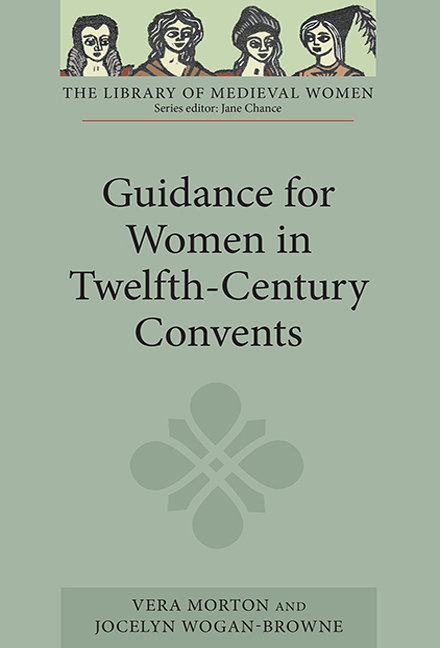Book contents
- Frontmatter
- Contents
- Preface
- Acknowledgements
- Abbreviations
- Introduction
- Note on Texts and Translations
- I Osbert of Clare, Prior of Westminster, to Adelidis, Abbess of Barking: A Thank-You Letter on Holy Widows, Virgin Fecundity and Precedents for Female Authority (Letter 42)
- II Abelard to Heloise: The History of Women's Roles in Christianity (Letter 7)
- III Peter the Venerable to his Nieces Margaret and Pontia: Of Nieces and Grandmothers and the Virgin Life at Marcigny (Letter 185)
- IV Osbert of Clare to his Nieces Margaret and Cecilia in Barking Abbey: Heavenly Rewards for Virgins in Barking (Letters 21 and 22)
- V Abelard to Heloise: On Educating Virgins (Letter 9)
- VI Goscelin of St Bertin: Lives of the Abbesses at Barking (Extracts)
- Interpretive Essay
- Bibliography
- Index
- Index
- Miscellaneous Endmatter
V - Abelard to Heloise: On Educating Virgins (Letter 9)
Published online by Cambridge University Press: 29 April 2017
- Frontmatter
- Contents
- Preface
- Acknowledgements
- Abbreviations
- Introduction
- Note on Texts and Translations
- I Osbert of Clare, Prior of Westminster, to Adelidis, Abbess of Barking: A Thank-You Letter on Holy Widows, Virgin Fecundity and Precedents for Female Authority (Letter 42)
- II Abelard to Heloise: The History of Women's Roles in Christianity (Letter 7)
- III Peter the Venerable to his Nieces Margaret and Pontia: Of Nieces and Grandmothers and the Virgin Life at Marcigny (Letter 185)
- IV Osbert of Clare to his Nieces Margaret and Cecilia in Barking Abbey: Heavenly Rewards for Virgins in Barking (Letters 21 and 22)
- V Abelard to Heloise: On Educating Virgins (Letter 9)
- VI Goscelin of St Bertin: Lives of the Abbesses at Barking (Extracts)
- Interpretive Essay
- Bibliography
- Index
- Index
- Miscellaneous Endmatter
Summary
Letter 9 of Abelard's correspondence with Heloise, written probably between 1132 and 1135, is concerned with learning and education. As in Letter 7's history of women and the Christian Church, Abelard's aim is to reach the spiritual values behind the practical injunctions. Abelard appears to have felt an affinity with Jerome (c. 342–420), the fourth-century doctor of the Church whom he takes as his principal source and model in this letter. Passionate, deeply learned, quick-tempered as they both were, they also suffered from scandalous comment on their association with learned women. While in Rome, Jerome had been a frequenter of the circle of rich, learned and austere Roman widows among whom Paula was a leader. He wrote to Paula's daughter-in-law, Laeta, in 403, in response to her request for advice in bringing up her daughter Paula. He dealt with the training of the little girl from her weaning, and when we remember that many inhabitants of nunneries and monasteries were oblates, offered to the Church as children, it is clear that their education would begin, as Paula's did, with learning their letters. Abelard seems to have envisaged this training as what the nuns might give children in their care and also as what Heloise might arrange for the instruction of older members of her community where necessary.
The education which Jerome advised and which Abelard repeated is strict in its controls on pleasure and worldliness, but both writers show great tenderness for the young child, who must be encouraged to learn by success, praise, and emulation. So far the object was to enable the child to read the Bible and to sing the psalms and canticles. For Abelard, however, this was only the beginning. The children were to be introduced gradually to the different books of the Bible so that they could learn the appropriate spiritual lessons without being led astray by what they did not properly understand.
Unlike those writers, such as Osbert of Clare, who stress the rewards chastity will bring to young women in conventual life, Abelard assumes his readers are chaste and virtuous and shows them the way of scholarship as an escape from idleness, frivolity, and temptation. He repeats Jerome's praise of Marcella, one of the widows of Rome, whose devotion to study made her constant in her pursuit of knowledge of the Scriptures.
- Type
- Chapter
- Information
- Guidance for Women in Twelfth-Century Convents , pp. 121 - 138Publisher: Boydell & BrewerPrint publication year: 2003



